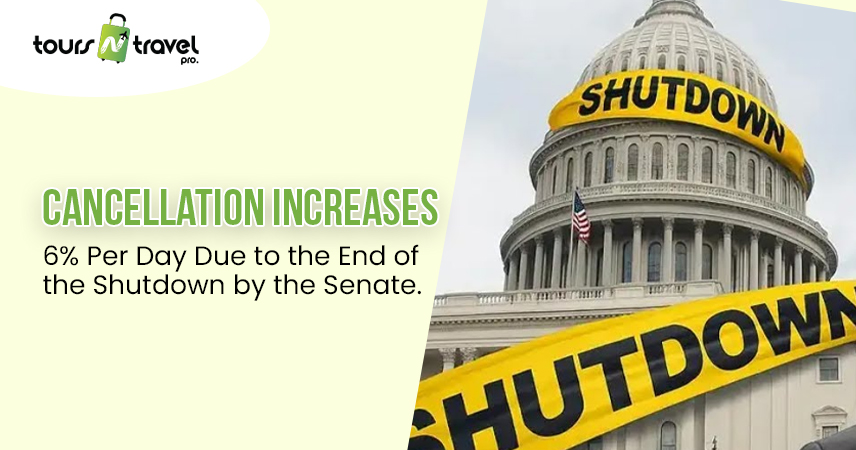On Tuesday, the Transportation Secretary Sean Duffy requested Congress to pass the bipartisan bill as early as possible that would remove the government shutdown and the disruptions that have plagued the country for a week. The measure, which garnered help from up to 8 Democrats and the backing of President Donald Trump, moved to the House.
The Senate has passed the legislation tonight to reopen the government and remove the record-long shutdown after eight democrats spoiled their party and joined the Republicans to break the logjam. The vote was around 60-40, with every Republican Senator running in favor of the measure.
The Progress Of Shutdown Moves In Senate, United Praises Votes!
- The recent federal government shutdown was caused by a disagreement over funding.
- It has become the longest in U.S. history, surpassing the previous record of 34 days set in 2018.
- While many government services came to a halt, important jobs like air traffic control and TSA workers were still required to work, but without getting paid.
- This situation put a lot of pressure on air travel and operations across the country’s airspace system.
- FAA has enacted the ground delay events at a few occupied hubs in the country as the staff levels dropped because of the financial strain.
- U.S airlines are forced to adjust their schedules not due to demand or weather issues, but because there were no required controllers available to operate airplanes.
- Similarly, the message from carriers became increasingly direct as this was not a capacity crunch, it was a staffing shortage.
- The Senate passed the bill on Monday morning after eight Democratic senators decided to break away from their party and vote in favor of moving forward with a spending bill.
- This means it will now go to the House of Representatives for their approval. The leaders in the House have indicated that they support it, which suggests the bill is likely to be signed by the President soon.
- If everything goes smoothly, it looks like the government shutdown could soon come to an end.
Daily Flight Cancellations By U.S Airlines
The Federal Aviation Administration (FAA) has started to cut the number of flights taking off and landing at major airports by 4% starting this past Friday. This decision comes due to a shortage of air traffic controllers and Transportation Security Administration (TSA) workers, many of whom have been working without pay for 42 days as of Tuesday. If things don’t change at the last minute, the flight reduction will increase to 8% on Thursday and then to 10% by Friday, according to the FAA.
As per the reports by the FAA, more than 2,400 U.S flights were cancelled on Monday, and only 4% flights were cancelled as mandated by the FAA. More than 5 million flyers have been affected due to the flight delay issues as the airports lacked enough controllers to manage all the traffic. There were only 11 flights cancelled from October 1 to October 29 due to the same staffing issues, but the number of cancellations increased to 4,162 from October 30 to November 9. The wide majority of these cancellations (3,756) occurred from November 7 to November 9 when the FAA started mandating flight reductions at up to 40 of the busiest airports.
Impact On Air Travel
Here is the information on how the recent shutdown removal by the Senate affects air travel:
- Ongoing Flight Cancellations: Even after the shutdown is over, there will still be flight cancellations for a while. This is because it will take time to get air traffic control staffing back to normal and sort out the complicated flight schedules.
- No Quick Solution: Airlines and the FAA (Federal Aviation Administration) are having talks about the situation, but there’s no promise on when the cancellations will end.
- Refund Information: If your flight is canceled or if you decide not to travel on a flight that is significantly delayed, airlines have to give you a full refund.
What Are The Broader Implications?
- Political Repercussions: The recent government shutdown has led to significant changes in political opinions. Many polls indicate that voters are more likely to blame the Republican Party for the shutdown rather than the Democrats, which could have an impact on upcoming elections.
- Healthcare Discussion: The agreement to end the shutdown includes a promise to hold a future vote on extending healthcare tax credits. However, it does not offer immediate help for those affected by healthcare issues.
- Impact on Other Services: The shutdown has also affected various federal programs, including food assistance for families (known as SNAP benefits), even as efforts are being made to pass a new funding bill.
Consequences For Further Air Travel
- The quick answer to the impact of a government shutdown on air travel is that not much will change right away.
- Even after the government reopens and air traffic controllers get paid again, simply returning to normal staffing levels won’t happen instantly.
- Unlike other airline workers, air traffic controllers can not just be added in a rush, and the Federal Aviation Administration (FAA) can not speed up the training for new hires without putting safety at risk.
- Airlines will take weeks to undo the schedule cuts they made during the shutdown.
- The process of getting air traffic control staff back to where they need to be will take time.
- So, while the shutdown might be resolved soon from a political standpoint, the effects on air travel will be felt well into early next year.
- There is also a harsh reality to consider that the US aviation industry can easily be disrupted by another budget crisis or ongoing political disagreements.
- Many travelers believe that air traffic control operates separately from politics but this shutdown has shown that it does not.
The Final Takeaway!
The Senate has approved a bill to end the government shutdown, but delays in flights are still expected. This is mainly due to ongoing staff shortages at the Federal Aviation Administration (FAA) and the time it will take to get everything back to normal. The agreement reached does not include a discussion on healthcare support, which may continue to be a controversial issue. Travelers should be prepared for disruptions for an unknown period as the system works to recover from the shutdown, even though the new funding will help federal workers financially in the short term.
For more inquiries regarding the flight cancellation increasing quantity due to the end of the shutdown, or manage your flight (change or refund) if your flight has also been cancelled, just give a call to Toursntravelpro.com experts at Call Us : +1-866-679-5070 and they will assist you over the call wisely.
Frequently Asked Questions
The cancellation increases 6% per day refers to the Federal Aviation Administration which is crucial for the airlines to lower their domestic flight schedules at 40 major airports by a daily increasing percentage. It starts with an initial 4% increase and rising to 6% on the provided day as per the FAA citing staffing shortage. This is a temporary measure to handle the air traffic during the shutdown and is not a reflection of airlines’ cancellation fees.
The cancellation fee refers to a charge for cancelling a booking, while the number of flights being cancelled refers to the number of flights that have been stopped. You must look at the context of the message to determine which is applicable.
Flight cuts are increasing day by day due to a government shutdown that impacted air traffic controllers’ ability to work, along with the cuts rising from 4% to 6% of flights. Similarly, the shutdown caused the controller fatigue and staffing shortage as some called out resigned. The reason behind it is the missed paychecks and financial stress and the FAA mandated further reductions to maintain safety.
Services like national parks, museums, and federal building tours are closed during a government shutdown, while the IRS stops most taxpayer correspondence and applications. Other affected services include the Small Business Administration which halts new loan approvals and new applicants for the passports and certain benefits may be delayed.
Major airports located in New York, Atlanta, Washington, Newark, and Chicago are experiencing flight delays and cancellations because of the government shutdown with the associated FAA capacity cuts.












